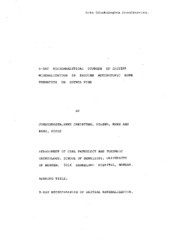X-ray microanalytical studies of initial mineralization in induced heterotopic bone formation in guinea pigs
Journal article
Submitted version
Permanent lenke
https://hdl.handle.net/1956/2189Utgivelsesdato
1981Metadata
Vis full innførselSamlinger
Sammendrag
Allogenic demineralized dentin implanted in the abdominal wall of guinea pigs induced heterotopic osteoid and bone formation. Samples of this tissue were frozen at -140° C, freeze-dried at -80° C, infiltrated with Spurr® epoxy resin and polymerized. The sections were studied in the scanning transmission electron microscope, and analytical studies were performed by means of energy dispersive microanalysis. Osteoblasts and young osteoid osteocytes contained much more calcium than undifferentiated cells and mature osteocytes. The Ca/P ratio in the cytoplasm of these young matrix-producing cells was high. Phosphorus was found in the nuclei of all cells and to a lesser degree also in the cytoplasm of cells rich in calcium. The initial extra-cellular mineral accumulation also showed a high Ca/P ratio. Small electron-dense areas in these regions exhibited both an amount of calcium and a Ca/P ratio resembling those of mature mineralized bone. The initial event of the mineralization process seemed to be an accumulation of calcium first in the young matrix-producing cells and then in the surrounding osteoid matrix. The results suggested that the matrix-producing cells are actively involved in the accumulation of calcium phosphorus both intra-and extra-cellularly.
